Liberal Party of Canada facts for kids
Quick facts for kids
Liberal Party of Canada
Parti libéral du Canada
|
|
|---|---|
 |
|
| Abbreviation | LPC PLC |
| Leader | Mark Carney |
| President | Sachit Mehra |
| House leader | Steven MacKinnon |
| Founder | George Brown |
| Founded | July 1, 1867 |
| Merger of | Parti rouge Clear Grits |
| Headquarters | |
| Youth wing | Young Liberals of Canada |
| Membership (2025) | |
| Ideology | Liberalism (Canadian) Social liberalism |
| Political position | Centre to centre-left |
| International affiliation | Liberal International |
| Colours | Red |
| Senate |
0 / 105
|
| House of Commons |
169 / 343
|
The Liberal Party of Canada (often called LPC or, in French, PLC) is a major political party at the federal level. It believes in liberalism, which focuses on individual rights and freedoms. The party is generally seen as being in the centre or centre-left of Canadian politics. Its main rivals are the Conservative Party (on the right) and the New Democratic Party (on the left).
The Liberal Party is known as a "big tent" party. This means it tries to attract support from many different types of voters. It is the oldest and longest-serving federal political party in Canada. For much of the 20th century, it held power for almost 70 years. Because of this, some people have called it Canada's "natural governing party."
The party started in 1867. It first came to power in 1873 with Alexander Mackenzie as prime minister. However, they lost power five years later. They returned to office in 1896 under Wilfrid Laurier, who was prime minister until 1911. Laurier's time was known for finding ways to bring together English and French Canadians.
The Liberals also governed from 1921 to 1930 and from 1935 to 1957. During these years, leaders like William Lyon Mackenzie King and Louis St. Laurent helped build Canada's welfare state. This means they created programs to help people, like social support. Lester B. Pearson continued to expand these programs from 1963 to 1968. His successor, Pierre Trudeau, also expanded social programs and promoted Canada's independence in the world.
After losing elections in 1984 and 1988, the party returned to power in 1993 with Jean Chrétien. He mixed social programs with careful spending. This continued under Paul Martin until the party lost power in 2006. The Liberals regained power in 2015 under Justin Trudeau, moving from third place to a majority government. As of 2025, Mark Carney is the party leader and prime minister.
Some important Liberal policies and laws include universal health care, the Canada Pension Plan, and Canada Student Loans. They also established the Royal Canadian Navy in 1910 and unified the armed forces in 1968. The Liberals have supported multilateralism (working with many countries), official bilingualism (French and English as official languages), and official multiculturalism. They also brought in gun control laws. A major achievement was bringing the Constitution of Canada home to Canada and creating the Canadian Charter of Rights and Freedoms. Other policies include the Clarity Act and national carbon pricing.
Contents
Party History
Early Years: 19th Century
How the Party Started
The Liberal Party grew from groups in the mid-1800s called "Reformers." These groups wanted responsible government in British North America. Important figures included George Brown and Alexander Mackenzie. The "Clear Grits" in Upper Canada and the "Rouges" in Lower Canada were also part of this movement.
These groups sometimes worked together in the government of the Province of Canada starting in 1854. But a truly united Liberal Party, with both English and French Canadian members, formed in 1867. Because of their link to the Clear Grits, modern Liberals are sometimes called "Grits."
After Confederation
When Canada was formed in 1867, the Liberals were not the main party. The Conservative group led by Sir John A. Macdonald was stronger. For 29 years after Confederation, the Liberals were mostly in opposition.
Alexander Mackenzie became the first official leader of the Liberal Party in 1873. He led the party to power that same year after the Macdonald government resigned due to a scandal. Mackenzie won the 1874 election and was prime minister for four more years. During his time, the Liberal government made many changes. They introduced secret ballot voting and created the Supreme Court of Canada. They also established the Royal Military College of Canada and the Office of the Auditor General. However, the party only had strong support in Ontario. In 1878, they lost the government to Macdonald. The Liberals then spent the next 18 years out of power.
Wilfrid Laurier's Leadership
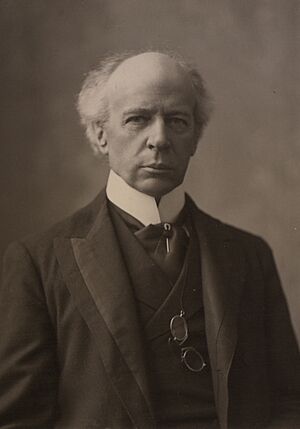
In its early days, the Liberals wanted Canada to be more independent from the British Empire. They also became popular with people in Quebec. This was because French Canadians were becoming unhappy with the Conservatives. The Conservatives lost support in Quebec due to events like the execution of Louis Riel and their opposition to French schools outside Quebec.
The Liberal Party became a modern party when Wilfrid Laurier became its leader. Laurier was able to attract French Canadians who were upset with the Conservatives. He also helped the party overcome its image of being against the Catholic Church in Quebec. In English-speaking Canada, the Liberals supported reciprocity (free trade with the US). This made them popular with farmers and helped them gain support in the growing prairie provinces.
Laurier led the Liberals to power in the 1896 election. He became the first French-speaking Prime Minister. His government encouraged immigration to settle Western Canada. Laurier's government also created the provinces of Saskatchewan and Alberta. They also helped Canadian industries grow.
20th Century Changes
Party Structure
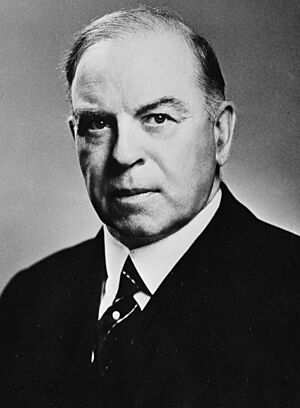
For a long time, the Liberal Party was a loose group of local and provincial organizations. It had a strong national leader and Members of Parliament. But there was no national membership. People joined by becoming members of a provincial Liberal party. Laurier held the party's first national meeting in 1893 to unite supporters. But no formal national organization was created outside of Parliament.
After losing elections in 1911 and 1917, Laurier tried to organize the party nationally. He created new groups, but they were often underfunded. The party held its second national meeting in 1919 to choose William Lyon Mackenzie King as Laurier's replacement. This was Canada's first leadership convention. After the party won the 1921 election, these new national groups became less important.
After losing the 1930 election, a central group called the National Liberal Federation was created in 1932. This helped coordinate the party. Over time, provincial Liberal parties became separate from the federal party. By the 1980s, the National Liberal Federation became officially known as the Liberal Party of Canada.
Canadian Independence
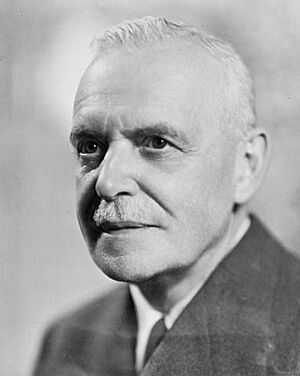
Under Laurier and William Lyon Mackenzie King, the Liberals worked for Canada's independence within the British Commonwealth. In meetings during the 1920s, Canadian Liberal governments argued that the United Kingdom and its dominions (like Canada) should be equal. They opposed ideas that would make Canada less independent. After an event in 1926, the Liberals argued that Canada's Governor General of Canada should no longer be chosen by the British government. These ideas became law in 1931.
The Liberals also wanted Canada to handle its own foreign and defence policies. In 1905, Laurier created the Department of External Affairs. In 1909, he appointed the first Canadian minister for foreign affairs. Laurier also suggested creating a Canadian Navy in 1910. Mackenzie King appointed the first Canadian ambassador to Washington in 1926. This showed the Liberal government wanted direct relations with the United States, not through Britain.
Building Social Support
Before and after the Second World War, the Liberal Party became a strong supporter of social programs. As prime minister for much of the time between 1921 and 1948, King introduced several measures. These led to Canada's social safety net. He introduced a monthly payment to mothers with young children. He also brought in old age pensions.
Louis St. Laurent became Liberal leader and prime minister in 1948. He led the party to two large majority governments in 1949 and 1953. As prime minister, he oversaw Newfoundland joining Canada. He also started equalization payments to provinces and improved pensions and health insurance. Canada had a strong economy during his time. In 1957, the Liberals lost to the Progressive Conservatives.
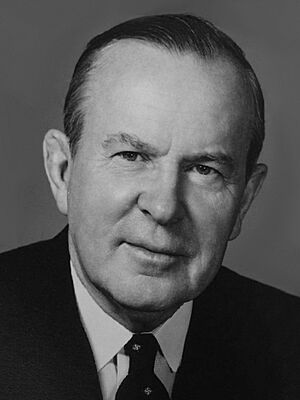
Lester B. Pearson became Liberal leader in 1958. He led the party to victory in 1963, forming a minority government. Pearson served as prime minister for five years, winning another election in 1965. Even though his governments were minorities, he left an important legacy. Pearson's government introduced Medicare (universal health care), a new immigration act, the Canada Pension Plan, and Canada Student Loans. His government also adopted the Maple Leaf as Canada's national flag.
Pierre Trudeau's Vision
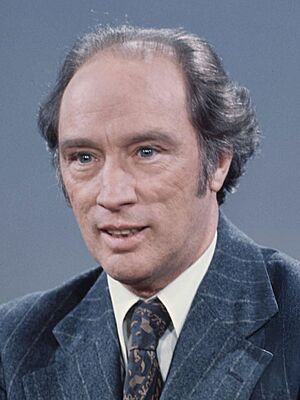
Under Pierre Trudeau, the idea of progressive social policy grew into creating a "just society." Trudeau's Liberal Party supported official bilingualism. They passed the Official Languages Act, making French and English equal in Canada. Trudeau hoped this would keep Quebec in Canada and allow Canadians to live anywhere without losing their language. This policy has helped protect the French language outside Quebec. It also ensures federal services are available in both languages.
The Trudeau Liberals also supported state multiculturalism. This helped immigrants join Canadian society without losing their culture. This policy helped the party gain support from new immigrants. It was a big change from earlier policies that had been unfair, like the Chinese Immigration Act of 1923 and the MS St. Louis incident.
The most lasting change from the Trudeau years was bringing the Constitution of Canada home to Canada. This also created the Canadian Charter of Rights and Freedoms. Trudeau's Liberals believed in a strong central government. They fought against Quebec separatism and the idea of Quebec being a "distinct society." However, these actions sometimes made many French Quebeckers feel distant from the party.
John Turner's Short Term

Pierre Trudeau stepped down as prime minister and party leader in 1984. John Turner became leader and prime minister. Turner quickly called an election. However, the party was hurt by many political appointments made just before Trudeau left. They were also unpopular in Quebec because of the Constitution changes that Quebec did not agree with.
The Liberals lost power in the 1984 election. They won only 40 seats, their worst defeat ever. The Progressive Conservatives won a majority in every province, including Quebec. Many wondered if the Liberals would become a minor party.
The party began to rebuild. A group of young Liberal Members of Parliament, called the "Rat Pack," became known for criticizing the Conservative government. Turner managed to keep his leadership. In the 1988 election, Turner strongly opposed the Canada-U.S. Free Trade Agreement. Even though many Canadians voted against free trade, the Conservatives won again. The Liberals recovered, winning 83 seats. This ended talk of them being replaced by the New Democrats.
Jean Chrétien's Era

Turner resigned as leader in 1989. Jean Chrétien became leader in 1990. Chrétien had served in every Liberal government since 1965.
Chrétien's Liberals promised to change the North American Free Trade Agreement (NAFTA) and get rid of the Goods and Services Tax (GST) in the 1993 election. They also released the "Red Book," which explained their plans for the economy, social issues, and foreign policy. They won a strong majority government with 177 seats. This was their third-best result ever. The Progressive Conservatives were reduced to only two seats. The Liberals won again in 1997 and 2000. Chrétien is the last Liberal Prime Minister to win three majority elections.
For the next decade, the Liberals were very strong in Canadian politics. This was partly because the Conservative vote was split between different parties. The Liberals won large majorities, especially in Ontario. However, they did not regain their strong position in Quebec, even though Chrétien was from Quebec.
While Chrétien's Liberals campaigned on progressive ideas, their time in power was marked by cuts to social programs. This was done to balance the federal budget. They made only small changes to NAFTA and supported free trade. They also did not get rid of the GST, except for replacing it with the Harmonized Sales Tax in some provinces.
After Quebec voted against independence in 1995, the Liberals passed the "Clarity Act." This law sets out the federal government's rules for negotiating provincial independence. In his last term, Chrétien supported legalizing same-sex marriage and signed the Kyoto Protocol on climate change. In 2003, Chrétien announced that Canada would not support the invasion of Iraq. This decision was very popular with Canadians.
In his final weeks, Chrétien introduced a law to limit donations to political parties. This was seen as a way for him to leave on a positive note.
21st Century Challenges
Paul Martin's Time

Paul Martin became party leader and prime minister in 2003. He had been the Minister of Finance and helped shape the Liberals' economic policies. Martin was expected to gain support in Quebec and Western Canada.
However, the political situation changed with the "sponsorship scandal." This involved advertising agencies linked to the Liberal Party receiving too much money. The Liberals also faced a strong challenge from the newly united Conservative Party led by Stephen Harper. There was also conflict between Martin and Chrétien's supporters. Despite this, the Liberals managed to win enough support to form a minority government in the 2004 election.
In 2005, Martin's government passed a law to legalize same-sex marriage across Canada. This made Canada the fourth country in the world to allow such marriages. In November 2005, the Martin government reached an agreement with Indigenous leaders called the Kelowna Accord. This plan aimed to improve education, housing, and health care for Indigenous peoples.
After a report on the sponsorship scandal was released, the Liberals lost support in polls. Martin's government lost a confidence vote in November 2005. He then asked the Governor General to call an election for January 2006.
The Liberal campaign was hurt by the sponsorship scandal. The Conservatives ran a smooth campaign. The Liberals lost power, winning 103 seats compared to 124 for the Conservatives. Martin resigned as Liberal leader in March 2006.
Struggles in Opposition
The next leadership election was held in December 2006. Stéphane Dion was chosen as leader. Dion had campaigned on environmental protection. This led to the "Green Shift" plan, which proposed a national carbon tax. This plan was a key policy for the party in the 2008 federal election. However, it was not popular and was attacked by other parties. On election night, the Liberal Party won only 77 seats. This was their lowest popular vote percentage in history. Dion announced he would step down as leader.
However, a political dispute in late 2008 made Dion's continued leadership difficult. Michael Ignatieff became interim leader. Ignatieff was formally named leader in May 2009.
When Ignatieff became leader, the Liberal Party was ahead in polls. But support fell as Ignatieff was seen as "missing in action." Ignatieff announced in August 2009 that the Liberals would not support the Conservative minority government. A month later, the Liberals tried to force an election, but the government survived. This attempt was seen as a mistake, as most Canadians did not want another election. Support for Ignatieff and the party continued to fall.
In 2011, Ignatieff successfully introduced a motion of no confidence against the government. This led to the 2011 election. The Liberals had some momentum at first. But opponents criticized Ignatieff for missing votes in Parliament. This was seen as a turning point in the campaign.
On election day, the Liberals suffered their biggest loss ever. They finished in third place, with only 19 percent of the vote and 34 seats. This was the first time the Liberals were not either the government or the official opposition. Ignatieff lost his own seat and resigned as leader. Bob Rae was chosen as the interim leader.
Many experts saw the 2011 election as a major shift in Canadian politics. Some wondered if the Liberal Party could recover.
Justin Trudeau's Return to Power

On April 14, 2013, Justin Trudeau, son of former prime minister Pierre Trudeau, was elected leader of the Liberal Party. He won 80% of the vote. After his win, support for the Liberal Party grew significantly.
In 2014, Trudeau removed all Liberal senators from the Liberal Party group. He said this was to ensure the Senate could properly check the prime minister's power.
By the time the 2015 federal election was called, the Liberals were in third place. Trudeau and his team ran a campaign focused on economic growth. The campaign was very successful. The Liberals won the election dramatically, with 39.5 percent of the popular vote and 184 seats. This was the first time a party won a majority government after finishing third in the previous election. Many called it a historic comeback for the Liberals.
In the 2019 federal election, Trudeau's Liberal Party lost 20 seats. However, they still won the most seats (157), allowing Trudeau to form a minority government. For the first time since 1979, the party with the most votes nationally did not win the most seats. The Liberals had 33.1 percent of the popular vote, while the Conservatives had 34.4 percent.
In the 2021 federal election, Trudeau and the Liberals secured a third term and a second minority government, winning 160 seats. However, they again came in second in the national popular vote, behind the Conservatives. They received 32.6 percent of the popular vote, the lowest percentage for a governing party in Canadian history.
In March 2022, Trudeau's Liberal Party made a deal with the New Democratic Party to ensure their support. In September 2024, Jagmeet Singh announced the end of this agreement. Throughout 2024, the Liberals saw their poll numbers drop. They lost in by-elections, even in areas they usually won. Media stories often talked about frustration with Trudeau's leadership. This led to a meeting where some members asked Trudeau to resign. Trudeau stated the party remained "strong and united." On January 6, 2025, Trudeau announced he would resign as party leader and prime minister after a new leader was chosen.
Mark Carney's Leadership

On March 9, 2025, Mark Carney was elected leader of the Liberal Party. He won 85.9% of the vote on the first try. In the 2025 Canadian federal election held on April 28, 2025, the Liberal Party under Carney gained seats in the Canadian House of Commons. They also won the popular vote for the first time since 2015. They received over 40% of the popular vote for the first time since 2000. The Liberal Party won 43.7% of the popular vote, their highest percentage since 1980.
Party Beliefs and Policies
The Liberal Party's beliefs are based on liberalism. These include individual freedom, responsibility, human dignity, and a fair society. They also believe in political and religious freedom, national unity, equal opportunities, cultural diversity, and working with other countries.
Since the early 1900s, the Liberal Party has supported a mix of policies from both the right and left sides of politics. When they were in government from 1993 to 2006, they focused on balanced budgets. They completely removed the budget deficit by 1995, by reducing spending on social programs or giving control to the provinces.
2021 Party Plan
During the 2021 federal election, the Liberal Party of Canada shared their plans. These plans included six main areas: the pandemic, housing, health care, the economy, climate change, and reconciliation with Indigenous peoples.
Some key Liberal policies from their 2021 plan included:
- Requiring travelers on trains, commercial flights, and other federally regulated vehicles to be vaccinated against COVID-19.
- Investing $6 billion to help reduce health system waitlists.
- Investing in building or improving 1.4 million new homes by 2025–26.
- Giving $2 billion over five years to address the history of residential schools. This money would support "truth, justice, and healing" efforts.
- Re-introducing a law to end the practice of conversion therapy for everyone.
- Working to achieve net-zero emissions by 2050 (meaning Canada would remove as much greenhouse gas from the atmosphere as it puts in).
- Creating a plan to fight hate by 2022, including a strategy for Black Canadians.
- Increasing the number of Afghan refugees Canada would welcome to 40,000.
- Creating a minimum tax rule so that high earners pay at least 15% in taxes each year.
- Setting up a permanent Council of Economic Advisors to give independent advice on long-term economic growth.
- Changing immigration programs to make it easier for temporary foreign workers and former international students to become permanent residents.
- Setting aside at least $1 billion to help provinces that ban handguns.
Election Results
House of Commons
| Election | Leader | Votes | % | Seats | +/– | Position | Status |
|---|---|---|---|---|---|---|---|
| 1867 | George Brown | 60,818 | 22.70 |
62 / 180
|
Opposition | ||
| 1872 | Edward Blake | 110,556 | 34.70 |
95 / 200
|
Opposition | ||
| 1874 | Alexander Mackenzie | 128,455 | 39.50 |
129 / 206
|
Majority | ||
| 1878 | 180,074 | 33.10 |
63 / 206
|
Opposition | |||
| 1882 | Edward Blake | 160,547 | 31.10 |
73 / 211
|
Opposition | ||
| 1887 | 312,736 | 43.10 |
80 / 215
|
Opposition | |||
| 1891 | Wilfrid Laurier | 350,512 | 45.20 |
90 / 215
|
Opposition | ||
| 1896 | 401,425 | 41.40 |
117 / 213
|
Majority | |||
| 1900 | 477,758 | 50.30 |
128 / 213
|
Majority | |||
| 1904 | 521,041 | 50.90 |
137 / 214
|
Majority | |||
| 1908 | 570,311 | 48.90 |
133 / 221
|
Majority | |||
| 1911 | 596,871 | 45.82 |
85 / 221
|
Opposition | |||
| 1917 | 729,756 | 38.80 |
82 / 235
|
Opposition | |||
| 1921 | Mackenzie King | 1,285,998 | 41.15 |
118 / 235
|
Majority | ||
| 1925 | 1,252,684 | 39.74 |
100 / 245
|
Minority | |||
| Opposition | |||||||
| 1926 | 1,397,031 | 42.90 |
116 / 245
|
Minority | |||
| 1930 | 1,716,798 | 45.50 |
89 / 245
|
Opposition | |||
| 1935 | 1,967,839 | 44.68 |
173 / 245
|
Majority | |||
| 1940 | 2,365,979 | 51.32 |
179 / 245
|
Majority | |||
| 1945 | 2,086,545 | 39.78 |
118 / 245
|
Minority | |||
| 1949 | Louis St. Laurent | 2,874,813 | 49.15 |
191 / 262
|
Majority | ||
| 1953 | 2,731,633 | 48.43 |
169 / 265
|
Majority | |||
| 1957 | 2,702,573 | 40.50 |
105 / 265
|
Opposition | |||
| 1958 | Lester Pearson | 2,432,953 | 33.40 |
48 / 265
|
Opposition | ||
| 1962 | 2,846,589 | 36.97 |
99 / 265
|
Opposition | |||
| 1963 | 3,276,996 | 41.48 |
128 / 265
|
Minority | |||
| 1965 | 3,099,521 | 40.18 |
131 / 265
|
Minority | |||
| 1968 | Pierre Trudeau | 3,686,801 | 45.37 |
154 / 264
|
Majority | ||
| 1972 | 3,717,804 | 38.42 |
109 / 264
|
Minority | |||
| 1974 | 4,102,853 | 43.15 |
141 / 264
|
Majority | |||
| 1979 | 4,595,319 | 40.11 |
114 / 282
|
Opposition | |||
| 1980 | 4,855,425 | 44.34 |
147 / 282
|
Majority | |||
| 1984 | John Turner | 3,516,486 | 28.02 |
40 / 282
|
Opposition | ||
| 1988 | 4,205,072 | 31.92 |
83 / 295
|
Opposition | |||
| 1993 | Jean Chrétien | 5,647,952 | 41.24 |
177 / 295
|
Majority | ||
| 1997 | 4,994,277 | 38.46 |
155 / 301
|
Majority | |||
| 2000 | 5,252,031 | 40.85 |
172 / 301
|
Majority | |||
| 2004 | Paul Martin | 4,982,220 | 36.73 |
135 / 308
|
Minority | ||
| 2006 | 4,479,415 | 30.23 |
103 / 308
|
Opposition | |||
| 2008 | Stéphane Dion | 3,633,185 | 26.26 |
77 / 308
|
Opposition | ||
| 2011 | Michael Ignatieff | 2,783,175 | 18.91 |
34 / 308
|
Third party | ||
| 2015 | Justin Trudeau | 6,928,055 | 39.47 |
184 / 338
|
Majority | ||
| 2019 | 6,018,728 | 33.12 |
157 / 338
|
Minority | |||
| 2021 | 5,556,629 | 32.62 |
160 / 338
|
Minority | |||
| 2025 | Mark Carney | 8,595,506 | 43.76 |
169 / 343
|
Minority |
Party Leaders
- George Brown (1867; unofficial)
- Edward Blake (1869–1870; unofficial)
- Alexander Mackenzie (1873–1880)
- Edward Blake (1880–1887)
- Wilfrid Laurier (1887–1919)
- Daniel Duncan McKenzie (1919; interim)
- William Lyon Mackenzie King (1919–1948)
- Louis St. Laurent (1948–1958)
- Lester B. Pearson (1958–1968)
- Pierre Trudeau (1968–1984)
- John Turner (1984–1990)
- Jean Chrétien (1990–2003)
- Paul Martin (2003–2006)
- Bill Graham (2006; interim)
- Stéphane Dion (2006–2008)
- Michael Ignatieff (2008–2011)
- Bob Rae (2011–2013; interim)
- Justin Trudeau (2013–2025)
- Mark Carney (since 2025)
See also
 In Spanish: Partido Liberal de Canadá para niños
In Spanish: Partido Liberal de Canadá para niños
- Liberal Party of Canada leadership elections
- Liberalism in Canada
- List of major liberal parties considered centre-left
- List of political parties in Canada
- Senate Liberal Caucus
- Trudeauism



